An Introduction to the Wheel of the Year
Helping you to understand the pagan Sabbats and how they can cultivate a slower, more mindful lifestyle
Have you ever heard of the wheel of the year? If you have, you’re my people. If you haven’t, let’s bring you into the fold and help you to understand these eight annual pagan celebrations and how they can help to slow things down in a delicious, juicy way, supporting a really gentle lifestyle in alignment with the seasons of the Earth.
The Wheel of the Year is essentially a representation of the yearly pagan holidays that follow the flow of the seasonal changes. Sea Witch Botanicals described it perfectly on their blog when they wrote:
“The Wheel of the Year is a modern conceptualization of cyclical seasonal celebrations that follow the ebb and flow of darkness and light over the course of a year. It contains eight holidays, or sabbats, altogether: four solar festivals (the equinoxes and solstices), and four fire festivals (each Celtic in origin, marking the halfway point between solstice and equinox). The calendar is heavily reliant on Celtic mythology and folk holidays, with some Germanic and Norse influences as well. “
The Wheel is a modern concept, developed in the early days of Wicca (which if you didn't know, is a more modern pagan organised religion), but I find it a really wonderful visual representation of the seasons and how the natural landscape evolves throughout the year.
The weather changes - the temperature is different, the trees change and our desires and inner landscape changes also.
These changes shift and then repeat each year, moving like the literal turn of a wheel. This is also a wonderful reminder for me that although sometimes things can feel hard or like you are in a situation that you can’t see a way out of, even in the darkest of times; the wheel continues turning.
There is no end, just a slow perpetual unfurling of the Earth’s magic month by month, day by day.
An unending series of opportunities to make different choices, new choices or the same choices if they are truly serving us well. The symbol of a circle, like the ouroboros, offers a sense of hope that there is a new dawn and a new dusk and that we have the chance to renew ourselves with each passing moment.
So, what does the wheel actually look like?
There are an infinite amount of different wheels out there in the world. You can find wheels with extra correspondences, celtic wheels, beautifully illustrated wheels, wheels carved into wood - there is something for everyone. As long as it has the eight sabbats, just pick the type of wheel that speaks to you the most (Etsy has some great options). The main thing to keep in mind is that the seasons happen at different ends of the year in the northern and southern hemispheres, so make sure you pick one that reflects where you live.
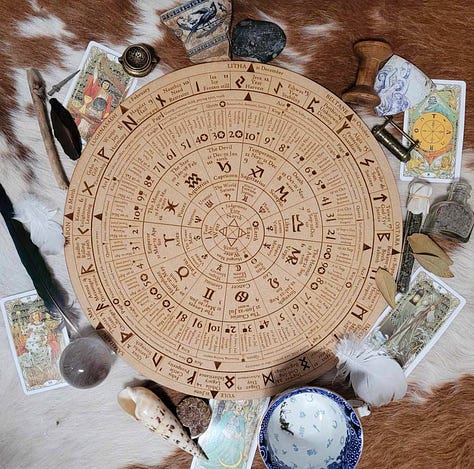
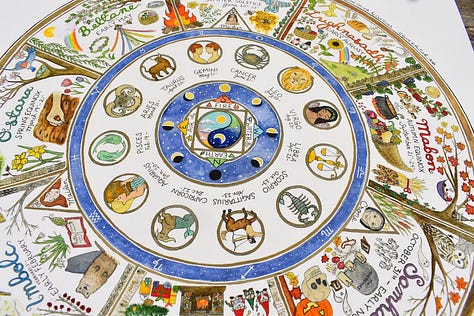
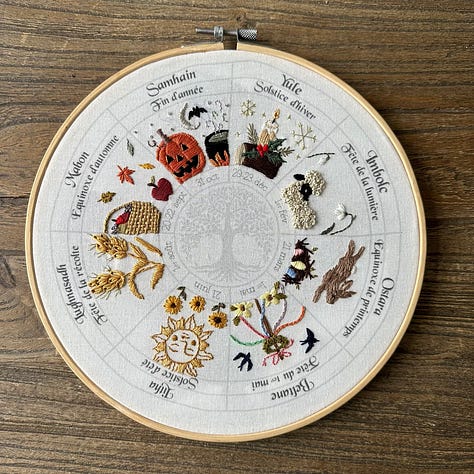

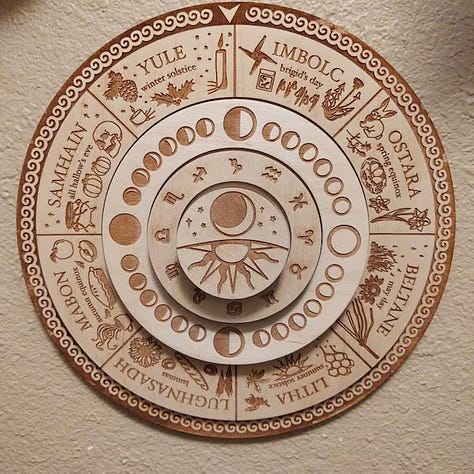
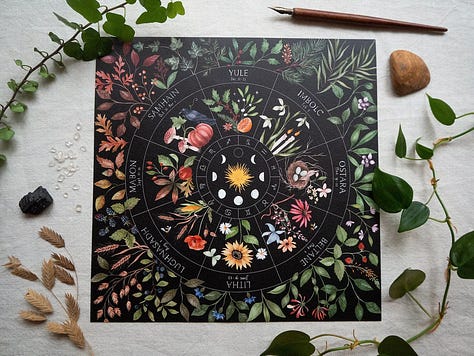
You can find these wheels available on Etsy via the links below:
Wheel 1 Wheel 2 Wheel 3
Wheel 4 Wheel 5 Wheel 6
Let’s dive into the basics of the eight sabbats. If you follow my podcast you’ll know I cover the sabbats more in depth there, and will also break them down one-by-one in more depth here on Substack too, but I want to make sure you have a basic understanding first.
Imbolc
This translates to “in the belly” or ‘in milk’, and is marking the midway point between midwinter and spring. The world is just starting to open up again after passing through the depths of winter, and it’s a time to celebrate the days becoming lighter and longer, and the air getting warmer. This is a great time for spring cleaning, starting to consider your spring gardens and the next year’s harvest while honouring the returning of the light. This sabbat is connected with the goddess Brigid, who is known as a symbol of fertility.Ostara
Easter, Ostara, easter, Ostara…. Do you hear a similarity? Essentially, this is a Celtic pagan easter and the spring equinox. Literally and metaphorically, Ostara is a time for planting seeds. Now is the time to plant the food that you will harvest in the autumn months, and the energetic seeds of what you want to bloom within yourself over the coming seasons.Beltane
This sabbat marks the cross quarter point between the spring equinox and summer solstice, and is one of the fire festivals of the year. It’s commonly known in many circles as ‘may day’ and was a time where groups would dance around a may pole, celebrating the beginning of the summer months. This is a time of sexuality and fertility, and is also (like Samhain) a time when the veil is thinnest. Many choose to connect with the fae during this time of year. Beltane was also a time where animals were moved pastures and the community focused on making offerings and calling in protection for the year, asking for crops to be watched over to ensure they could feed their families in the following winter.Litha
The summer solstice! One of my favourite celebrations. Litha is a joyful time of abundance and plenty, the height of summer and a time to celebrate the closeness of the sun to the Earth. This festival also marks the longest day of the year, giving way to the shortening of days as we head towards the darker part of the year and toward the harvest. A time for fae, food, plenty of drink and a good hearty dance.Lughnasadh
The first harvest, also known as ‘loaf-mass" - this is a time of year where the first grains were ready for harvest. People would celebrate by milling their grains and making fresh bread. It was also a time that was quite crucial for people, as they began to see whether their crops had flourished enough to feed their families for the winter. A feast is traditional on this cross-quarter celebration, with lots of berries and summer fruits.Mabon
The last harvest. If your crops had done well, you would be celebrating with deep gratitude for the provisions that would carry you through the darker months. This is a time for gourds and the last fresh fruits and vegetables from the summer crops before the rest that could be preserved would be, to be enjoyed in the winter. This festival has been likened to a pagan thanksgiving, and is a great time to take stock of what has happened over the year and use it as a time for release. Now is a good opportunity to also clear out your home and add extra protections, getting ready for spending more time indoors in the winter.Samhain
You may know of some traditional Samhain celebrations woven into what is now modern halloween. The veil is thin, and the time is right to connect with and honour your ancestors and all who have come before you. It’s the perfect time to reflect on the cycles of death and rebirth, and some consider it the witch’s new year (although many prefer to mark this at the winter solstice, myself included). Have a feast and set a place for your departed loved ones, and spend extra time on your altars, ensuring to make a space for your ancestors. Samhain (meaning summer’s end) can be a great time for mulled wine and warm cider, and all of the delicious autumn foods.Yule
The winter solstice, also known as the witch’s new year and pagan Christmas. There are quite a few traditions and myths surrounding this sabbat, but it was a time where people would feast, give gifts to each other, make offerings to the gods to help them to survive the winter and protect their homes. Yule logs were actually a pagan tradition, and this time of year people would gather to celebrate the returning of the light. It also represents in some pagan circles the victory of the Oak King over the Holly King, but this is a story for another time (or a great one to read about in Frances Billinghurst’s book linked below).
I find that the Wheel of the Year can be such a beautiful ally for helping us to come back into alignment because it really forces us to pay attention and just slow down.
If you decide to include it in your everyday and/or spiritual practise, it will demand that you connect with nature and what is happening outside your window each day. What does the air feel like, smell like? Is there a crunch of dead leaves underfoot? Are bees buzzing and flowers blooming, swaying in a warm summer breeze? Building your relationship with nature in this way truly is a sensory experience. In our home we love having a roast to celebrate the sabbats, its something special we do to mark the time and honour each other as we cycle through the seasons ourselves.
It’s a great time to take stock, reflect on the time that has passed and make plans for the coming months. It can be a wonderful connector in relationships too, both romantic and otherwise. Spend it with your extended loved ones or use these times as a bridge to reclaiming communication and closeness with your partner, there is no wrong way to celebrate as long as it feels good for you.
Some resources I love the most when it comes to understanding and working with the Wheel of the Year include a few books and a website. Firstly, I use the Spheres of Light site each year to find the exact southern hemisphere dates for the sabbats. Over the years I have found a few books to be really helpful for learning and getting creative with the sabbats. These include:
Llewellyn’s Sabbat Almanac - These are released each year with different contributors, but you can use them forever. I find them great for new ideas each year! Bear in mind, these are written for the northern hemisphere.
Dancing the Sacred Wheel by Frances Billinghurst - Frances is an Australian author, and this book is written specifically for Aussie witches. I love the way she writes, and really brings in the Indigenous Australian lore and environmental observations also.
Witchy Magic by Lucy Cavendish and Serene Conneeley - This might not be everyone’s cup of herbal tea, but I have always loved this title as a quick reference guide to a variety of witchy things. It would be perfect for beginners and is written by Aussie authors too!
The Wheel of the Year: An Illustrated Guide to Nature’s Rhythms - I am about to purchase this one and will do a review here on Substack, but it is just so beautiful and a wonderful way to work with the sabbats alongside children.
One of my personal favourite ways to acknowledge the turning of the wheel is to use it as a time to refresh my altars throughout my home. I have two main altars in the living area, and so it’s a great time to take foraged items back out into nature, find more natural items to bring inside (for example, I’ve just found some beautiful pine cones for our autumn altars), switch out crystals, colours, cloths, candles, deity symbols and give them a good deep clean! This is not only good home hygiene, but is also good spiritual hygiene and particularly if you work with a deity or nature spirits (the fae) it’s particularly important to do as a sign of respect (you don’t want your keys to go missing every day because you annoyed a faerie).
This practise can also be a great conversation starter for children as to why we select certain items for particular times of the year, why the weather is changing and why it’s important that we keep energy fresh and flowing in the home. If you were homeschooling or unschooling it could absolutely spin off into a discussion and research project on the seasons, weather changes, pine cones and pine trees, animal patterns in the season, what plants grow that time of year and so much more.
I hope this has given you a good understanding of the basics of the Wheel of the Year, and that you feel confident and inspired to start working with it in your own home. It’s a journey that starts small, and builds as you grow in your practise - slowly infusing intention and connection with the Earth (plus a good dose of magic) into all facets of your daily life. If this has resonated with you in some way, or you would love to share ways that you have worked with the wheel in your life then comment below; I’d love to hear from you.




